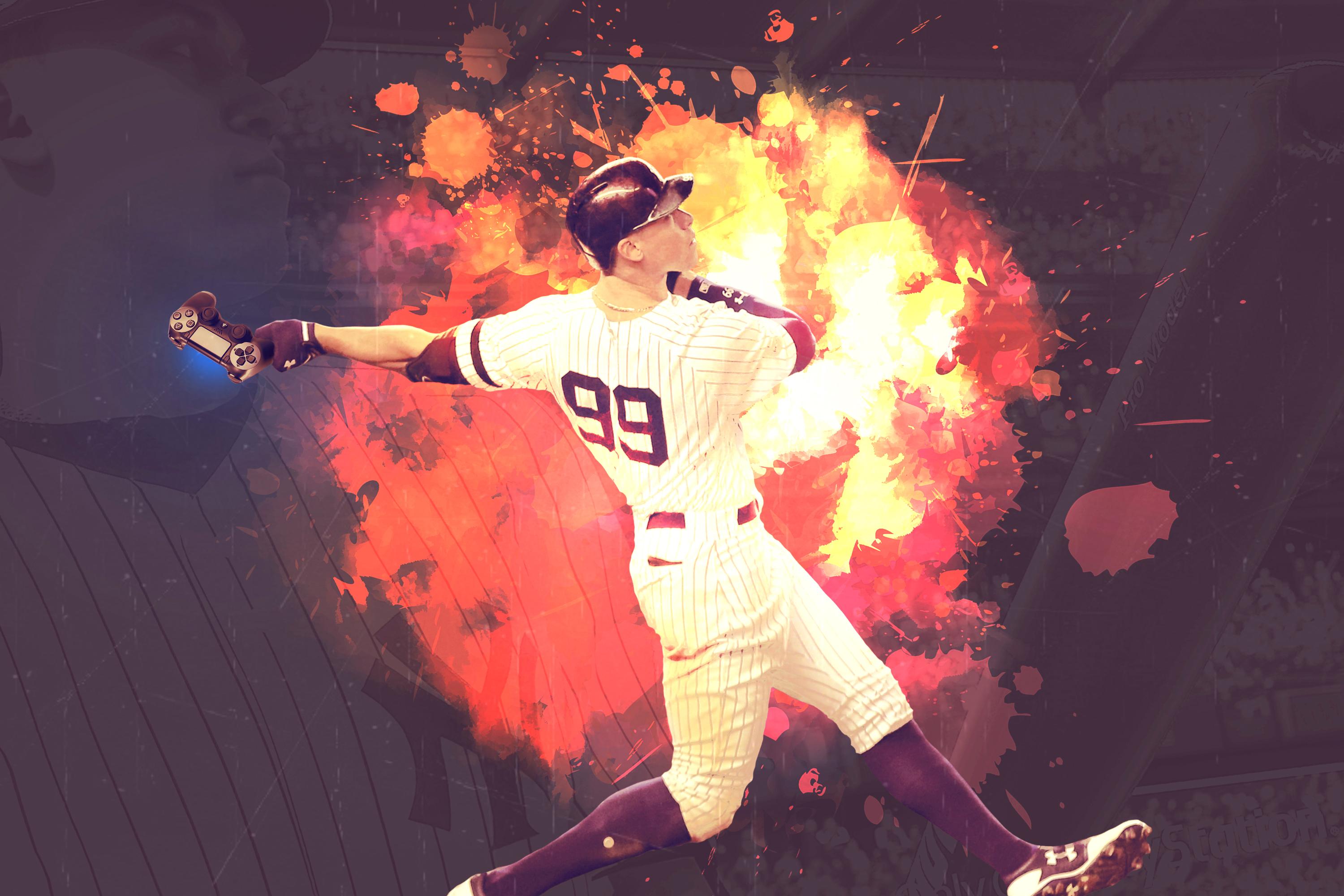
Ninety years before baseball’s latest and greatest home run barrage ignited a new round of debates about the baseball’s construction, Major League Baseball put its thumb on the scoring scale in a way that might seem suggestive to today’s fans. In the middle of the 1925 major league season, the Reach Company, MLB’s official baseball supplier, introduced the “cushioned cork center ball.” Ostensibly, the new, dual-layer rubber coating around its cork core was intended to make the ball more durable. But it was also designed to deaden offense, which had risen to record levels in the wake of earlier changes to the ball that had made it more lively and given hitters greater incentive to swing for the fences. Through July 1925, MLB teams had generated 5.47 runs and .557 home runs per nine innings; after July, with the new ball in use, those rates sank to 4.73 and .355, respectively.
Scoring stayed steady for a few years thereafter, but by the end of 1930, offense had ramped up again. In response to that surge, both leagues elected to raise the stitches on the ball, which was expected to give pitchers a better grip, increase breaking-ball movement, and raise air resistance, thereby decreasing carry. Because the American and National leagues differed on the degree to which they wanted scoring to subside, though, MLB adopted two different balls for the first and last time in its long history.
From 1931-33, AL hitters punished the more offense-friendly ball, which had a three-ply horsehide cover, to the tune of 5.15 runs and .517 home runs per nine innings. NL hitters, who took their hacks at a five-ply horsehide cover that required an extra stitch and resulted in slightly more bunching at the seams, generated only 4.38 runs and .436 home runs per nine innings. That three-year period served as a natural experiment, proving that seemingly small alterations to the ball—the 1931 NL ball was only 4 percent bigger and heavier than the AL ball, with slightly higher seams—could have a huge impact on the field.
None of those archaic adjustments to the sport posed a problem for the not-yet-existent studio Sony Interactive Entertainment San Diego, which was 70-plus years away from releasing its first version of MLB the Show. Since SIE San Diego’s PlayStation series debuted in 2006, though, the game on the field has gotten more fierce, featuring record-setting strikeout rates and record-high home run rates. And when the game on the field changes, so does the game in the game—the most recent edition of which, MLB the Show 18, came out Tuesday.
“We’re trying to model what happens in real life,” Chris Gill, The Show’s senior producer and gameplay designer, says by phone. The people who purchase The Show’s new installment each spring, he adds, “actually want the game to be as real as possible, and it’s only as real as the year prior.” That means that along with delivering the new gameplay features and annual incremental graphical upgrades that keep players coming back, the developers have to test and tweak The Show’s virtual version of baseball to bring it into line with the real-life league’s results.
Lately, those results have looked a lot different. Research published by The Ringer, FiveThirtyEight, The Hardball Times, and, oddly enough, Justin Verlander’s Twitter account, has revealed that the baseball itself has almost certainly been behind the game’s rapidly rising home run rate: Compared to balls made before the sudden surge in home runs that struck the sport unexpectedly in 2015, balls from more recent MLB action appear to be bouncier, smaller, and flatter-seamed, which means that they tend to leave the bat faster and fly farther. Even more recent investigations indicate that the ball isn’t the same on the inside, either, which helps explain its aberrant behavior. Although the physical differences in the old and new ball are small, the effects are large, which MLB’s multiple models of baseball demonstrated during the Depression, when a young Vin Scully was still stumbling over dead horses in the street.
If the real-life ball is juiced, then The Show’s commitment to accuracy demands that the digital baseball be juiced, too—or, at least, that roughly the same number of home runs be hit. Much of the modeling behind that task falls to Jeff McArthur, The Show’s lead artificial intelligence and physics engineer. Like Gill, who’s been at Sony since 1998, McArthur has been building baseball games since The Show’s precursor series, MLB. When he joined the team in 2004 and rebuilt the physics system from scratch, he had little information to go on beyond Robert Adair’s seminal book The Physics of Baseball, which helped him lay the foundation for the flight of the ball. After almost 15 years of iteration, McArthur is probably one of the world’s most knowledgeable sources on how the ball behaves. “I definitely have thought about it a lot more than most people,” he says.
Over time, the increasing availability of ball-tracking data has helped McArthur refine his early, more rudimentary model. “Basically what I’m trying to do with the physics, with all the variables and everything, is to get it so it represents how balls are actually hit in the real world,” he says. For MLB the Show 17, McArthur devoted himself to modeling the spin of the ball off the bat, using trial and error to pinpoint the correct rates by plugging in numbers until the flight of the virtual ball matched the flight of real-life batted balls launched at similar angles and speeds. That process relied on data displayed at the now-defunct site Hit Tracker, as well as a more comprehensive source of batted-ball stats that the studio purchased and McArthur and Gill decline to identify. The reward for that work, Gill says, was “an infinite number of hit results,” headlined by hit types that once wouldn’t have happened ever or often in earlier games, including curving flies down the line and liners up the middle that would more frequently fall in front of outfielders rather than hanging up for easy outs.
Having completed that project, McArthur’s goal for the game’s latest edition was a thorough audit of the data from last year’s release. “The goal was if you saw something on the screen, like Aaron Judge hit a ball 110 miles per hour at a 25-degree angle 10 degrees left of center field, if you just punched in those numbers in our game, that the ball would land within a couple seats or in the same area as the ball that you saw on television,” he says. His review revealed a problem: When he entered the batted-ball data from Hit Tracker into The Show’s in-game engine, the virtual balls weren’t landing in quite the same spots as their physical counterparts. “The ball wasn’t flying as far as it should have when it was hit way up in the air,” he says.
That specific departure from the real-life results wasn’t directly related to a change in the physical ball. After checking his code, McArthur determined that the problem was probably air density: An incomplete equation had caused the ball to act as if it was soaring through wet air at all times. When he addressed that oversight, the model’s outputs matched up more closely with the balls launched by big league batters.
Because the game’s physics are constantly tweaked and began to approach their current complexity only within the past few years, McArthur can’t specify exactly how much livelier the ball is in MLB the Show 18 than it was in, say, MLB the Show 14, before the hike in home run rate. As MLB’s home run count has climbed, though, the team has tweaked the ball’s behavior accordingly. “If we come in at the end of a year and the home run rates are off by a certain percentage from what we wanted them to be, then yeah, we will look at everything, including changing parameters of the ball,” McArthur says.
For McArthur, increasing or reducing batted-ball distance is a less labor-intensive process than it was for Reach or would be for Rawlings. If he notices that MLB batted balls are flying five feet farther than the year before, there are “a couple constants” he can futz with in the physics. “Just tweaking them a little bit makes the ball move. … I can move it 10 feet forward or backward with just small changes to a couple of numbers.” One factor, for instance, is called “seam,” which affects how the ball cuts through the air and, by extension, how well it carries. “I have numbers from zero to one … that I could play with for how the ball is cutting through the air,” McArthur says. Adjusting the game’s strikeout rate is even easier: All Sony has to do is simulate thousands of games and compare the results they produce to the corresponding MLB baselines, then nudge them one way or another. “Rather than model all the nuances that could go into it, we just model the end results,” McArthur says. “If the rates go up, we just change the rate.” Commissioner Manfred (who’s probably a fan of “Fast Play” mode) might envy that kind of control.
Compared to the finer physics work required to nail the look and behavior of every batted-ball type one would see in an MLB game, Gill says, adjusting the power is “not really the hard part.” Nor does Sony necessarily need to model every aspect of the ball’s behavior down to the most granular level. “All we’re trying to do every single year is copy what’s happening in real life,” Gill says. “We don’t really care how it happens so much as we care about what the result is. … So whether they [lowered] the seams on the ball, or the ball’s juiced or whatever, it’s kind of irrelevant to us.” Although the studio’s adjustments might make The Show’s ball behave more like an altered MLB ball, they’re closer to fudge factors than perfect reflections of reality. “You could pretend that those numbers represented something in the real world, like the shape of the ball or how big the seams were,” McArthur says, adding that “the effects of air and seams end up playing out in the game almost exactly as they would.”
The physical ball’s behavior isn’t the only development driving higher home run rates: To take advantage of the ball’s increased carry, more and more hitters have started swinging for the fences, just as they did when the dead ball went away. The Sony squad is sensitive to human factors, too: McArthur played baseball through college, while Gill, a former infielder, made it to Double-A with the Reds and later worked for the franchise as a scout. But while The Show attempts to recreate players’ looks, including their stances and swings, the company can’t capture every player’s mechanics on a personalized level, especially in the era of unceasing swing overhauls. “If we assign Justin Turner a swing and then next year he goes and changes his swing, now all of a sudden we’ve put all this work into everybody’s swing and then we have to adjust it again,” Gill says. Instead, Sony uses swing templates and tries to come as close to the real thing as possible, applying updates as needed on an annual basis.
New mechanics, of course, can affect player performance, and the team can adjust an avatar’s attributes independent of the swing the player sees on the screen. “Underneath the hood, the notion of uppercutting and the angle of the bat as it’s moving through, whether it’s going through flat or on a downslope or an upslope, those are not really taken from the animation data—it’s hidden underneath,” McArthur says. That layer of obfuscation allows him to tweak the effect of bat meeting ball without a cosmetic makeover. “If we did see more fly balls, I can adjust that,” he continues. “I can adjust the swings, the uppercuts of swings, and how the bat is pretending to be relative to the ball on contact. So we do have control over that. … It’s actually pretty complicated. We’re modeling the swing of the bat underneath, kind of separate from the animations for gameplay and a whole bunch of other reasons. But the end result is accurate.”
While the developers implement most major changes in The Show’s annual releases, more minor adjustments needn’t always wait ’til next year. For example, when he has sufficient data about the ball’s behavior in Chase Field this season, McArthur could account for the effect of the ballpark’s new humidor in an online update, without holding off on a fix until 2019. “That’s something we could patch,” he says. For next year’s release, he’s planning to continue to make The Show’s swing types and ball flight more accurate—although what “more accurate” means will depend on the bounces of an unpredictable ball. “Every year we’re trying to get better,” McArthur says. So are big league batters, and SIE San Diego is perpetually trying to keep up.


